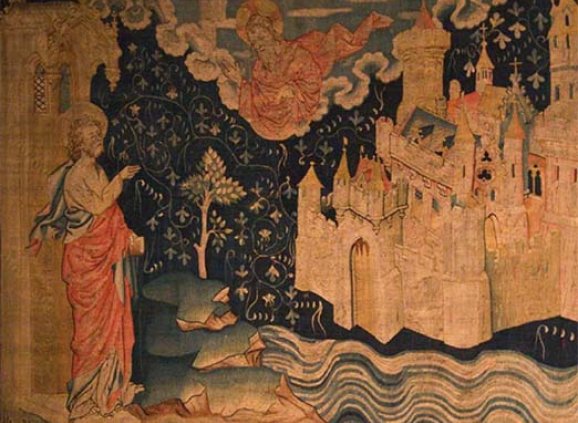
- Education Forums
Eschatology, the Second Coming, and the Book of Revelation

Related Forum Video
I Thessalonians 4:13-18
Revelation 20:11-15; 21:1-7, 22-27; 22:1-21
Reflection
Eschatology and the Second Coming
Eschatology refers to thoughts about the end times, the end of history as we know it, and the coming of the day of God and of Christ. Scattered throughout the New Testament are references to the “day of the Lord,” which was understood to be the day when history as we know it would end, when God would judge the living and the dead, and when Christ would come for a second time to bring to resurrection those who had been faithful to him and the ways of the Gospel.
Before the coming of Jesus, Hebrew Scripture had also looked for the coming of the “day of the Lord,” though for Jews then and now, that day was not, of course, associated with the second coming of Jesus. The “day of the Lord” was understood to have two aspects wrath for the enemies of God and of God’s people, and blessings for the people of God. In the many ups and downs that the people of Israel experienced during their being conquered by large empires that overran them, and then their restoration after such times, the coming of the Lord was understood to be God’s way of righting wrong, and bringing blessing to those who had been wronged.
But there was a third dimension to the understanding of what God would bring about through the “day of the Lord.” That day would be an opportunity for Israel itself to repent of its own sins and injustices, and to join God in the restoration of a world of justice and peace.
In Christian understanding, the waiting for Christ’s second coming draws to itself the concepts of the “day of the Lord” that were present in Hebrew Scripture, while adding new dimensions. The New Testament understanding of Christ’s second coming seems to have two major dimensions to it. The first is the full establishment of the Kingdom of God that Jesus has proclaimed in his earthly ministry, especially in his many parables about the coming of the Kingdom. In this way, the waiting for Christ’s second coming is also an eager anticipation of the healing of all earth’s troubles and the coming of a new age of blessing and goodness. The second aspect of the New Testament’s understanding of Christ’s second coming is that it will be the time of the resurrection of the dead, and the time of judgment of the living and the dead, in which all Christians – and perhaps all people – are judged according to the standards of the Gospel and how their lives either conformed to that Gospel or did not.
The Book of Revelation – also known as The Revelation to St. John the Divine or The Apocalypse
The Book of Revelation, the final book in Christian Scripture, is the strangest book in the entire New Testament. It is an example of what is known as apocalyptic writing. (The Book of Daniel in Hebrew Scripture is also an example of this sort of writing.)
Apocalyptic writing springs up during times when God’s people are in crisis, due to war, persecution, or some other sort of terribly threatening circumstances. It is often written in strange code language, a language that cannot be understood by those who persecute the people of God, but will be readily understood by the faithful. It is written to accomplish two major purposes: (1) to assure the faithful that the forces oppressing them will not win out in the long run; and (2) that God is with them, and will strengthen them to persevere through the dire times they are in.
The Book of Revelation, most scholars agree, was written during the persecutions of Christians under Nero. Nero reigned from 54-68 A.D./C.E., and it is believed that he set fire to Rome so that he could clear land to build himself a great palace. Nero blamed the fire on Christians, and several Roman historians accuse Nero of dipping Christians in oil, and using them as living human torches for his garden parties. The number 666 (the number of the beast) is a coded numerical form of Nero’s name. It is almost certain that both St. Peter and St. Paul were executed during the persecutions of Christians that Nero undertook.
The imagery of Revelation – full of violence and seemingly merciless judgment – is distasteful to many people of modern sensibilities in the first world. But if you can imagine yourself into the place of early Christians being persecuted under Nero, you can – perhaps – understand why the violent and vindictive images and texts of Revelation were sources of comfort and strength to those being persecuted. In our own time, to Christians under various threats in other parts of the world, the imagery of Revelation is often received with great joy, as a comfort and strength for the difficulties they are experiencing. As in the reading of all Scriptural texts, the context of one’s personal life – as well as the context of one’s time and culture – will have a huge impact on how one reads and understands the Book of Revelation. To those of us who feel frightened and under various threats, Revelation and the Jesus who suffers but conquers will provide solace and strength, helping us to persevere. For those of us who feel largely satisfied with life, and who do not want our lives turned upside down, Revelation’s images of a world destroyed to make way for a new world may feel threatening and repugnant.
The Book of Revelation portrays Jesus in varied ways, as a sacrificial lamb, but also as a conquering hero. Depending on our specific life contexts, we may be drawn to some or all of the images of Jesus in Revelation, or we may find some or all of them strange, or even repulsive. The imagery of a new heaven and new earth in Chapter 21, however, appeal to most of us at one time or another in our lives. Whenever the present time and circumstances of the world – and/or of our individual lives – make us feel less than sanguine about the direction things are headed, we may well yearn for a new heaven and earth, and the coming of the Lord Jesus who will be God’s instrument for the remaking of things, for a starting-over that promises things will be better. If we feel desperate, then we may even yearn for Jesus to come quickly and soon (Revelation 22:20), and for this present vale of tears to be superseded by a world in which:
“[God] will wipe every tear from their eyes.
Death will be no more;
mourning and crying and pain will be no more.” (Revelation 21:4)
– The Rev. Bill Rich
Poetry
“Jerusalem” – William Blake (1757-1827)
And did those feet in ancient time
Walk upon England's mountains green?
And was the holy Lamb of God
On England's pleasant pastures seen?
And did the Countenance Divine
Shine forth upon our clouded hills?
And was Jerusalem builded here
Among these dark Satanic Mills?
Bring me my bow of burning gold!
Bring me my arrows of desire!
Bring me my spear! O clouds, unfold!
Bring me my chariot of fire!
I will not cease from mental fight,
Nor shall my sword sleep in my hand
Till we have built Jerusalem
In England's green and pleasant land.
Music
Hymn: And did those feet in ancient time
Art
Tapestries of the Apocalypse, Angers, France – “The New Jerusalem”

- January 2024
- December 2023
- November 2023
- October 2023
- September 2023
- June 2023
- May 2023
- April 2023
- March 2023
- February 2023
- January 2023
- December 2022
- November 2022
- October 2022
- June 2022
- May 2022
- April 2022
- March 2022
- February 2022
- January 2022
- November 2021
- October 2021
- September 2021
- August 2021
- July 2021
- June 2021
- May 2021
- April 2021
- March 2021
- February 2021
- January 2021
- December 2020
- November 2020
- October 2020
- September 2020
- August 2020
- July 2020
- March 2020
- February 2020
- January 2020
- December 2019
- November 2019
- October 2019
- September 2019
- August 2019
- July 2019
- June 2019
- May 2019
- April 2019
- March 2019
- February 2019
- January 2019
- December 2018
- November 2018
- October 2018
- September 2018
- August 2018
- July 2018
- June 2018
- May 2018
- April 2018
- March 2018
- February 2018
- January 2018
- December 2017
- November 2017
- October 2017
- September 2017
- July 2017
- May 2017
- April 2017
- March 2017
- February 2017
- January 2017
- December 2016
- November 2016
- October 2016
- September 2016
- August 2016
- May 2016
- April 2016
- March 2016
- February 2016
- January 2016
- December 2015
- November 2015
- October 2015
- October 2013
- September 2013
At "Educational Forums," enrich your spiritual journey by exploring our resources including videos of lectures, essays by priests, and other pieces about our faith, our church, and what it means to be a disciple of Jesus in the 21st century.


Comments